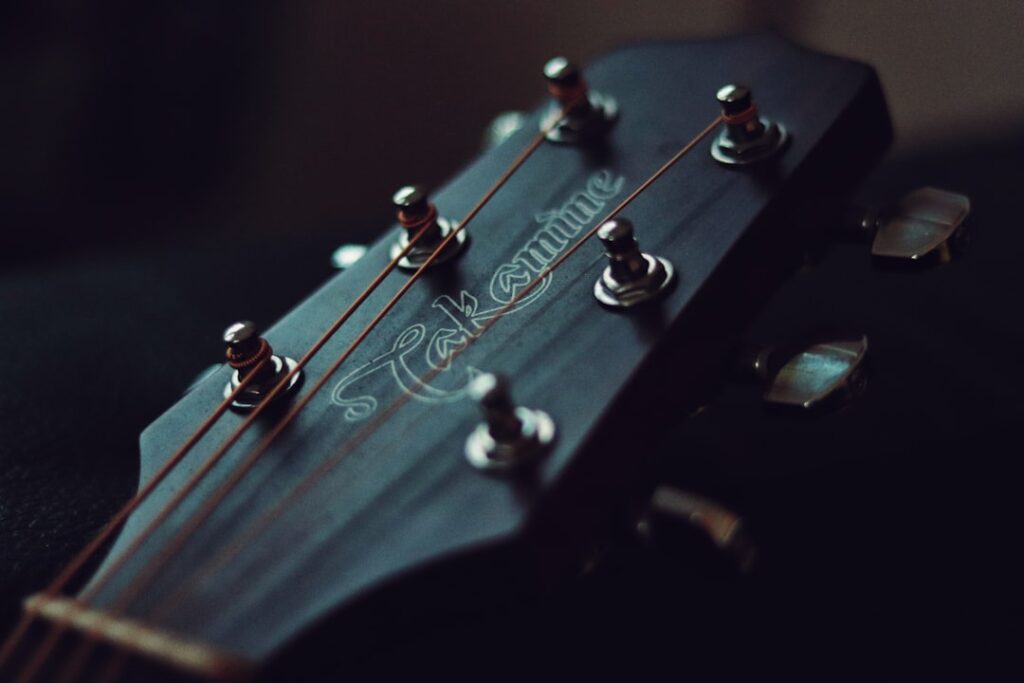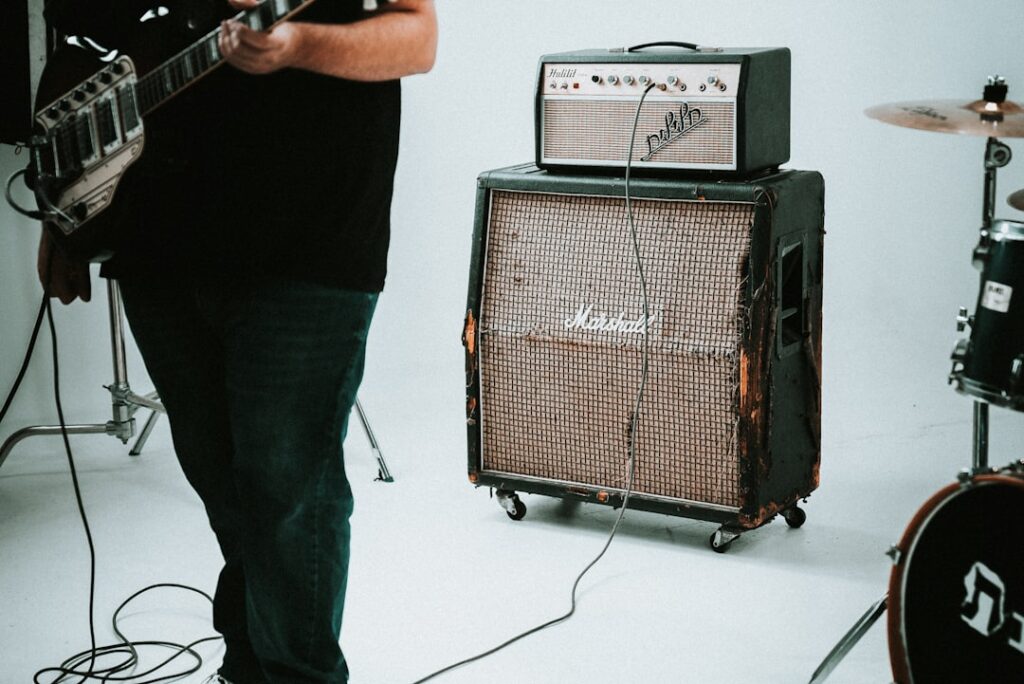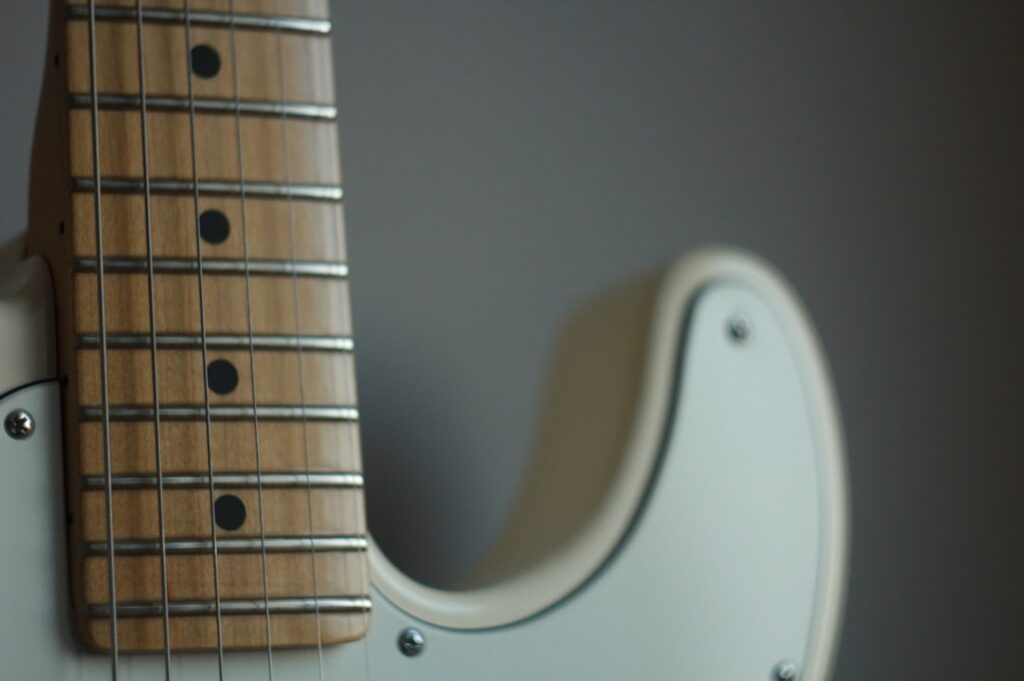- ① Introduction: The Unique Sound Aesthetic of Ukigumo (Ryosuke Nagaoka)
- ② Amp Selection and Tonal Philosophy – Ukigumo’s Clean Foundation
- ③ Guitar Selection and Signature Instruments – A Curated Chaos
- ④ Effects and Signal Chain Philosophy – Controlled Chaos Underfoot
- ⑤ EQ Philosophy and Stage Sound Design – Crafting Sonic Architecture
- ⑥ Suggested Budget Alternatives for Achieving Ukigumo’s Tone
- ⑦ Conclusion: The Art of Restraint in Ukigumo’s Guitar Philosophy
① Introduction: The Unique Sound Aesthetic of Ukigumo (Ryosuke Nagaoka)
Known for his role as the guitarist of the iconic Japanese band Tokyo Jihen (Tokyo Incidents), as well as his solo project Petrolz, Ukigumo—real name Ryosuke Nagaoka—is one of the most distinctive and creative players in Japan’s modern guitar scene. His approach to tone and phrasing is truly one-of-a-kind, blending subtle muting, jazz-influenced voicings, and sudden injections of wah-filtered leads. The result is a guitar style that constantly surprises and engages the listener.
Whether it’s the jagged funk rhythms on “Gunjou Biyori”, the unpredictably angular stabs in “Sōdōteki Sanpunkan”, or the sweet yet edgy leads in “Killer Tune”, Ukigumo’s playing always carries a signature musical fingerprint—one that’s both genre-defying and unmistakably his own.
What sets Ukigumo apart is not just technical ability, but the synergy between his tonal sensibility and musical intuition. Even when drenched in effects or pushing boundaries with boutique or DIY gear, his sound remains uniquely “Ukigumo.” His rig is full of character—not just standard guitars and pedals, but oddball finds, vintage pieces, and custom-modded tools that reflect his creative spirit.
His gear has been documented extensively by fans and gear sites like kizai-zukan.com and m-u-t-e.com, where you can find breakdowns of his pedalboards and guitar arsenal.
In this article, we’ll take a deep dive into how Ukigumo crafts his tone—from guitars and amps to effects and EQ tricks. We’ll also explore how you can recreate his sonic essence using more accessible gear, without losing the soulful depth and creativity that define his sound.
▶ Search Official Tokyo Jihen MVs on YouTube
② Amp Selection and Tonal Philosophy – Ukigumo’s Clean Foundation
Ukigumo’s guitar tone is marked by a wide dynamic range and subtle tonal coloration, yet the foundation of his rig is surprisingly straightforward: clean, full-bodied tube amps that serve as neutral platforms for his extensive pedalboard.
While specific amp models are rarely confirmed in official sources, interviews and live footage suggest he primarily relies on Fender-style clean amps and Marshall-style low-gain crunch amps. According to features in Guitar Magazine Japan and photos from major live performances, it’s clear that distortion is handled by pedals, while the amp is chosen for its headroom and character.
Notably, live footage from albums like “Goraku” or “Daihakken” reveals him using Fender-style cabinets and VOX-style combos. These amps deliver shimmering highs and smooth mids, making them ideal platforms for Ukigumo’s eclectic guitar collection and wide tonal shifts.
Even when distortion is heavily used, his amps remain set to clean. Instead of amp overdrive, he shapes his gain through pedals like the Roger Mayer Voodoo-1 and Phantom FX Hizumi Station, both known for their saturated but articulate voicings. This approach ensures his amp never muddies the tonal detail of his pedals.
In recent years, it’s speculated that Ukigumo has leaned on Fender Hot Rod Deluxe and Fender Twin Reverb—both known for their generous clean headroom, clarity, and excellent pedal compatibility. These choices reflect his commitment to tone shaping at the pedal and EQ level, rather than relying on amp coloration.
Here’s a summary of amps most likely used by Ukigumo, as inferred from interviews, live footage, and gear sources like m-u-t-e.com.
| Model | Brand | Amazon URL | Artist | Guitarist | Notes |
|---|---|---|---|---|---|
| Hot Rod Deluxe | Fender | Search on Amazon | Tokyo Jihen | Ukigumo (Ryosuke Nagaoka) | Excellent clean amp for pedals. Gain is always pedal-driven. |
| Twin Reverb | Fender | Search on Amazon | Tokyo Jihen | Ukigumo (Ryosuke Nagaoka) | Great for clarity and time-based effects in a live mix. |
| AC-30 (Estimated) | VOX | Search on Amazon | Tokyo Jihen | Ukigumo (Ryosuke Nagaoka) | Chimey mids, seen in live/MV footage. Possibly his go-to for jangly tones. |
| DSL40CR (Estimated) | Marshall | Search on Amazon | Tokyo Jihen | Ukigumo (Ryosuke Nagaoka) | Natural crunch tones with clean+boost flexibility. |
③ Guitar Selection and Signature Instruments – A Curated Chaos

Ukigumo’s guitar arsenal defies genre stereotypes—it’s eclectic, messy by design, and yet every detail is intentional. His choices reflect not only his tonal needs, but also his theatrical flair and unpredictable stage presence.
Most notably, Ukigumo is closely associated with offset guitars, particularly Fender Jazzmasters and Mustangs. Their naturally scooped mids, expressive vibrato systems, and quirky aesthetics align with his experimental sound. For instance, live footage from “Daihakken” and “Color Bars” features Ukigumo wielding a Jazzmaster loaded with P-90-style pickups—delivering gritty bite and clear note separation, even under fuzz or modulation.
He also frequently plays a Fender Pawn Shop Offset Special, a rare hybrid guitar that combines Jazzmaster body shape with Strat-style controls and humbuckers. This guitar reflects Ukigumo’s love for modded gear and unconventional tools.
In addition to Fenders, Ukigumo occasionally uses Gretsch semi-hollow bodies or vintage Japanese guitars (like Teisco or Guyatone) for their tonal color and visual eccentricity. These instruments, though sometimes seen as low-fi, are integral to his spontaneous tone shifts and textural layering.
Ukigumo’s guitars are often modified with mismatched knobs, stickers, or custom pickguards—mirroring the chaotic beauty of his musical approach. His instruments aren’t just tools; they’re extensions of his personality and stage character.
| Model | Brand | Amazon URL | Artist | Guitarist | Guitar Type | Notes |
|---|---|---|---|---|---|---|
| Jazzmaster | Fender | Search on Amazon | Tokyo Jihen | Ukigumo (Ryosuke Nagaoka) | Offset Solid Body | Loaded with P-90-style pickups. Perfect for surf-meets-fuzz textures. |
| Pawn Shop Offset Special | Fender | Search on Amazon | Tokyo Jihen | Ukigumo | Offset Hybrid | Rare factory-mod guitar with unique wiring and humbuckers. |
| Gretsch G2622 | Gretsch | Search on Amazon | Tokyo Jihen | Ukigumo | Semi-Hollow | Used in layered studio work. Warm, airy midrange. |
| Guyatone LG-70 (Est.) | Guyatone | Search on Amazon | Tokyo Jihen | Ukigumo | Vintage Solid Body | Lo-fi charm, often seen in solo projects or TV appearances. |
④ Effects and Signal Chain Philosophy – Controlled Chaos Underfoot
Ukigumo’s pedalboard is a living, breathing sketchpad—an ever-evolving experiment in tone and texture. From the razor-sharp cuts in Tokyo Jihen to the dreamy haze of Petrolz, his effects reflect his musical fluidity and refusal to stay in one lane.
His core drive tone historically revolves around the Roger Mayer Voodoo-1 Classic, known for its bold midrange and British-style grit. During the “Adult” and “Variety” eras, this was often his main distortion source. Complementing this are pedals like the Ibanez TS9 (often modded) and the Fulltone Full-Drive 2 (White), which add smoother textures or harmonic richness, depending on the song’s mood.
In later Tokyo Jihen albums and especially in solo or Petrolz work, the Phantom FX Hizumi Station has become a key component—offering both compression and focused aggression. Developed by fellow experimental guitarist Kenji Totaka, it blends thickness with clarity, which perfectly suits Ukigumo’s layered tones.
When it comes to fuzz, Ukigumo doesn’t shy away from chaos. He often toggles between a Z.Vex Fuzz Factory and an Electro-Harmonix Big Muff Pi, depending on whether he wants sputtering instability or sustained saturation. These fuzz tones are used sparingly but effectively—more as emotional punctuation than constant distortion.
His modulation and spatial effects are chosen not for shimmer or flash, but for creating sonic dimension. A BOSS DD-5 has long been a delay staple—set with tight repeats and short trails to add rhythmic clarity. For more atmospheric songs, he switches to the MXR Carbon Copy Deluxe or the BOSS DD-500, allowing for subtle stereo spread and tweakable subdivisions. His go-to reverb is the Strymon blueSky, offering deep, lush ambience used especially in Petrolz’s slow-burning grooves.
Modulation pedals like the MXR Phase 90 or Fulltone Choralflange are chosen for their warmth and slight unpredictability. Tremolo also plays a significant role in his dynamic expression—particularly the BOSS TR-2 or Fulltone Supa-Trem, both known for delivering rhythmic pulse without overshadowing the band’s groove.
Wah pedals are not just filters for Ukigumo—they’re part of the arrangement. He’s been seen using the Jim Dunlop BG-95 (Buddy Guy model) with polka-dot paint, and sometimes even a VOX wah borrowed from Ringo Sheena herself. His approach blends tonal coloration with performative flair, often integrating wah sweeps as compositional elements.
He also explores quirky, less common effects like the Xotic Robotalk RI (Auto-Wah) and Subdecay Prometheus DLX (Filter Modulator), proving that his board isn’t about what’s trendy, but about what fits the song—or disrupts it creatively.
| Pedal | Manufacturer | Amazon URL | Artist | Guitarist | Type | Notes |
|---|---|---|---|---|---|---|
| Voodoo-1 Classic | Roger Mayer | Search on Amazon | Tokyo Jihen | Ukigumo | Distortion | Mainstay distortion during the “Adult” to “Variety” era. |
| Hizumi Station | Phantom FX | Search on Amazon | Tokyo Jihen | Ukigumo | Distortion | Modern fuzz/drive hybrid used extensively in later works. |
| Fuzz Factory | Z.Vex | Search on Amazon | Tokyo Jihen | Ukigumo | Fuzz | Unstable and expressive. Ideal for dramatic accents. |
| blueSky | Strymon | Search on Amazon | Tokyo Jihen / Petrolz | Ukigumo | Reverb | Used for immersive ambient textures and trailing delay/reverb blends. |
| DD-5 | BOSS | Search on Amazon | Tokyo Jihen | Ukigumo | Digital Delay | Classic compact delay for rhythmic clarity and minimalism |
| BG-95 | Jim Dunlop | Search on Amazon | Tokyo Jihen | Ukigumo | Wah Pedal | Signature look and sound; often used as dynamic enhancer. |
⑤ EQ Philosophy and Stage Sound Design – Crafting Sonic Architecture

Ukigumo’s tonal approach is less about brute force and more about precise placement—each frequency carefully sculpted to serve the music, whether in a sprawling Tokyo Jihen arrangement or a sparse Petrolz groove.
On stage, he often places his guitar slightly left-of-center in the stereo field, ensuring it retains clarity without clashing with the lead vocal or piano. This is particularly evident in Tokyo Jihen’s live mixes, where Ringo Sheena’s voice is the nucleus and Ukigumo’s guitar flutters around it like an angular satellite—present but never overpowering.
Midrange is king in his EQ philosophy. Whether using analog amps or modelers like the Fractal Axe-Fx II/III, he boosts the upper mids (around 1.6–2.5kHz) to emphasize note definition and clarity in complex chord voicings. At the same time, he tightens the low end using a modest high-pass filter (60–90Hz range) to prevent boominess—especially crucial when performing with 7-piece ensembles.
Treble is handled delicately. Rather than excessive brightness, he allows natural harmonic sparkle to emerge through touch dynamics and pickup selection, rather than relying on amp settings. Presence controls on amps like the Marshall JVM410H or Matchless Chieftain are dialed conservatively—just enough to give air, not harshness.
His rig is often tuned to accommodate pedal stacking. For example, a TS9 or Hizumi Station may boost mids before hitting an already-compressed amp. In such cases, Ukigumo will slightly dip overlapping frequencies via EQ blocks (around 750Hz–1kHz) to avoid honkiness or tonal congestion.
In studio sessions or smaller venues, he adapts quickly using the Axe-Fx III’s global EQ or IR (impulse response) libraries, often choosing cabinets with open-back characteristics to soften projection and add dimension. For larger halls, tighter closed-back cabs or IRs modeled after Celestion V30s help maintain definition at higher volumes.
It’s also notable that Ukigumo frequently relies on in-ear monitoring in modern performances. His monitor mix reportedly favors drums and bass more than vocals—suggesting that rhythmic locking takes priority over melodic cues in his live phrasing and improvisation.
Ultimately, his EQ strategy is not static—it’s a living extension of the band’s structure. As the arrangement shifts, so does his role: sometimes occupying dense chordal space, other times fading into reverb-laced feedback. It’s this awareness and restraint that make his tone so unique—not always “beautiful,” but always intentional.
⑥ Suggested Budget Alternatives for Achieving Ukigumo’s Tone
Reproducing Ukigumo’s tone may seem daunting at first glance, especially considering his reliance on rare vintage guitars and boutique effects. However, by focusing on the tonal characteristics he prioritizes—such as rich midrange, tight fuzz texture, and expressive modulation—guitarists on a tighter budget can approximate his style using accessible alternatives.
🎛️ Distortion & Overdrive
A cornerstone of his tone, especially during the Kyōiku and Adult eras of Tokyo Jihen, is a slightly compressed yet harmonically complex overdrive. If boutique options like the Roger Mayer Voodoo-1 are out of reach, the Ibanez TS9 is an excellent substitute. It preserves clarity while enhancing midrange punch, making it a versatile base drive that pairs well with most clean amps.
For fuzz textures reminiscent of his work on Bon Voyage or Petrolz material, the boutique Z.Vex Fuzz Factory is ideal, but the JHS Mini Foot Fuzz or Electro-Harmonix Little Big Muff can deliver a similarly rich, unruly character—perfect for expressive noise interludes or raw melodic leads.
🌊 Reverb & Delay
Spatial depth is a key feature in Ukigumo’s tone, especially in his solo or Petrolz work. While he often uses high-end pedals like the Strymon BlueSky or BOSS DD-500, budget-conscious alternatives like the Zoom MS-70CDR or NUX Atlantic offer excellent multi-FX reverb and delay combinations. Zoom’s pedal, in particular, allows for dual modulation setups that emulate the lush stereo spread of more expensive rigs.
If you’re after a straightforward digital delay, the TC Electronic Flashback Mini or BOSS DD-3T will get you in the ballpark of the short repeats Ukigumo uses in tracks like “Killer Tune.” Their compact form factors make them ideal for minimalist boards.
🔄 Modulation & Wah
To replicate his signature use of tremolo and phaser, budget units like the Joyo JF-09 Tremolo or Behringer UT300 Vibrato offer solid analog-style movement. These effects are most noticeable in Petrolz arrangements, where subtle modulation adds dimension without overwhelming the mix.
As for wah, Ukigumo is known to use custom Dunlop models, including the polka-dot BG-95. For players seeking similar tonal sweep and expressive control, the widely available Dunlop CryBaby GCB-95 provides the same essential sound and feel, minus the visual flair.
| Category | Model | Brand | Approximate Role |
|---|---|---|---|
| Overdrive | TS9 | Ibanez | Mid-rich, smooth clipping |
| Fuzz | Little Big Muff | EHX | Warm, textured fuzz |
| Delay | Flashback Mini | TC Electronic | Short, crisp delays |
| Reverb/Mod FX | MS-70CDR | Zoom | Reverb + chorus + modulated verbs |
| Tremolo | JF-09 | Joyo | Subtle rhythm modulation |
| Wah | CryBaby GCB-95 | Jim Dunlop | Expressive filter sweep, budget-friendly |
⑦ Conclusion: The Art of Restraint in Ukigumo’s Guitar Philosophy

If one were to encapsulate Ukigumo’s approach to guitar tone in a single phrase, it would be “the aesthetics of texture.” His sound is neither about flashy solos nor extreme volume—it’s about presence. A presence so subtle yet so integral that a single note can shift the atmosphere of an entire song.
Among Tokyo Jihen’s lineup of musical heavyweights, Ukigumo continuously redefined the role of the guitar—never just accompanying, but shaping the sonic identity of the band through carefully chosen tonal gestures. He’s less a guitarist, and more a “sound designer within a musical narrative.”
His gear choices reflect this mindset. Rather than collecting effects for their novelty, Ukigumo employs each pedal with clear intention—balancing function, timbre, and contextual relevance. His tones on Adult, Variety, or Bon Voyage evolve not simply because of technological upgrades, but because the stories he wanted to tell sonically changed.
What truly sets him apart is his subtractive design philosophy. In an era of increasingly dense and loud guitar tones, Ukigumo pares back—removing unnecessary frequencies, trimming the gain, narrowing the stereo image. This approach ensures that each sound has a purpose and that his guitar never interferes with vocals or other instruments. It completes the song, rather than competing with it.
Importantly, recreating his tone doesn’t demand exotic gear or expensive amplifiers. Instead, it requires a deep understanding of spatial placement, EQ carving, and the delicate use of modulation. Learning how to apply tremolo or wah just enough, how to let reverb breathe without washing out the mix—these are the hallmarks of his sonic fingerprint.
Finally, Ukigumo’s philosophy is rooted in this idea: He doesn’t just play guitar—he designs sonic environments. Adopting this mindset may not only help you get closer to his tone but might also unlock new levels of creativity and restraint in your own playing.
His tone is “unmistakably unique, yet universally captivating.” And at the heart of that uniqueness is an unwavering dedication to aesthetic integrity and tonal storytelling.






